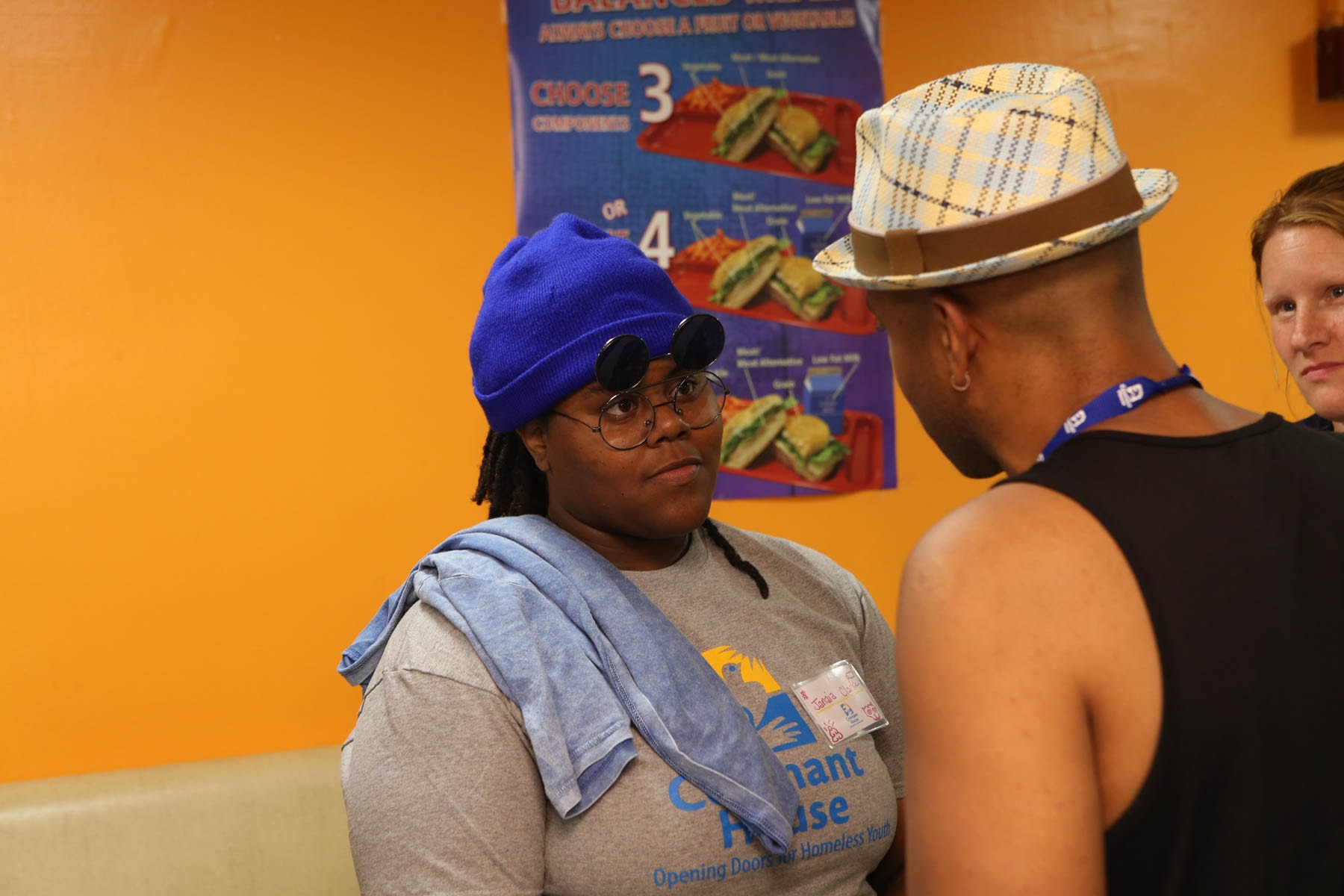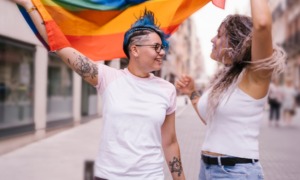He brought candy to that first meeting at the Covenant House homeless shelter in Manhattan a few days after Halloween — a universal ice breaker, he figured. Each month he kept coming back, one time helping the mainly gay, lesbian and bisexual youth decorate for Christmas, another time discussing their fears in a changing political world.
Darius De Haas had served as unpaid board member for Covenant House since 2014, but was new in this role as part-counselor, part-friend to young people seeking shelter and hope in a journey that left them homeless, often abandoned by their own families.
With each visit he became more comfortable, looking forward to getting to know a new group of teens. De Haas has spent nearly two decades on Broadway, appearing in “Rent,” “Kiss of the Spider Woman” and winning an Obie Award for “The Running Man.,” but that made no difference to the young people during monthly meetings at Covenant House.
“A few of them knew I was somebody, I guess, but let’s be honest, most of them didn’t know who I was and didn’t care,” De Haas said.
He knew them, though, at least a little bit. Growing up black and gay on Chicago’s South Side, De Haas had never been homeless, but he’d been bullied, chased by gangs and endured the sometimes terrifying moments life brought for people like him.
Covenant House has been providing shelter and support for homeless U.S. teens, straight and gay alike, since 1972. Headquartered in New York City, its shelters are spread across 30 cities in the United States, Canada and Latin America, providing temporary homes for about 50,000 youth annually. In the past decade, Covenant House and shelters across the country have developed specialized services for LGBT youth who are often alienated and preyed upon on the streets.
More awareness, better care
About 1.6 million youth become homeless in America for at least a short stretch each year, according to studies cited by such diverse sources as the National Conference of State Legislators and the National Network for Youth. Nearly 40 percent of those teens identify as LGBT, according to homeless advocates and an extensive 2015 survey by the Williams Institute, a UCLA School of Law think tank dedicated to advancing laws promoting gender rights.
The Williams Institute Study found 80 percent of LGBT homeless youth either ran away from home or were forced out by parents upset with their sexual identities. The report shares findings from a spring 2014 survey of 138 youth homelessness service providers nationwide, and shows that compared to their non-LGBT youth peers, LGBT youth experienced homelessness for longer durations and presented with higher levels of depression, anxiety and other mental health symptoms. Most providers said the health of transgender youth was worse than cisgender (identity aligns with gender assigned at birth) peers, and a higher proportion of transgender youth (90 percent) had experienced trauma such as family rejection, harassment or bullying based on their sexual orientation or gender identity, compared with 70 to 75 percent of LGBT youth.
“When LGBT kids come to us, a lot of them had been rejected by their own families, have been targets of abuse for years,” said Kathy Colbenson, CEO of CHRIS 180, an Atlanta-based nonprofit that provides shelter and other services for homeless youth, and was one of the nation’s first to provide specialized services for LGBT youth. “It’s a different kind of lonely when you are not wanted. Our mission is to make them feel accepted and safe, and then to help people heal.”
That was De Haas’ intent one night this winter, when a new group of about 16 young people gathered around the Covenant House shelter. He’d been able to secure a copy of “Moonlight,” the Academy Award-nominated film about a child who is poor, neglected and black, growing up gay in Miami’s impoverished Liberty City.
Unlike his previous meetings, De Haas said he was surprised that movie night attracted nearly as many straight kids as LGBT youth living in the shelter. A Jamaican boy, whom De Haas said identified himself as straight, was particularly vocal, defending the movie’s hero against the barrage of taunts, name calling, parental neglect and chronic drug abuse on screen. He’d grown up that way himself, he said, as did many others in the room.
Others chimed in, agreeing and discussing aspects of the movie they could relate to. A bond between these teens — gay, lesbian, transgender, bisexual and straight — seemed to have formed.
“Bear in mind we had kids in various stages of coming into who they are, establishing their own identity. I didn’t do this to say it’s a great film you should love, I wanted to see if it was something they would identify with. Would it have a ring of truth?” De Haas said. “We’re trying to reach these kids, make them feel comfortable with themselves and their identities.”
Inclusion offers best results
While the number of shelters dedicated exclusively to caring for the LGBT community is growing, about 80 percent are general service facilities catering to the needs of all youth, said Nick Seip, a spokesman for the True Colors Foundation. That makes it crucial to integrate the teens while still providing safe havens for LGBT youth, homeless advocates said.
The integrated facilities, sometimes run by religious groups long hostile or ambivalent about LGBT rights, are making the biggest changes and efforts. They also offer the best path to successful outcomes for all youth experiencing homelessness, advocates and providers said.
Perhaps nobody has been working longer to help homeless LGBT kids, or seen more changes, than Colbenson of CHRIS 180 in Atlanta, which provides long- and short-term housing for homeless kids, training on LGBT issues among other youth-care topics, family services and counseling. When she started in 1987, the organization
(then called CHRIS Kids) was primarily offering foster care and homeless services.
“I immediately saw that LGBT youth were in the program, and even in my organization people weren’t as accepting or as inviting as they could be,” Colbenson said.
“Nobody else was serving LGBT back then. We were pretty much winging it on our own, but with a very strong clinical background,” Colbenson said. “The approach I used, clinically, you have to listen to someone’s voice. And people can’t heal until they are acknowledged and accepted for who they are.”
Her philosophy was unique, and not particularly welcome in her state of Georgia, Colbenson said. The organization changed its anti-discrimination policy in 1989 to be inclusive to everyone, drawing anger even from other foster care and homeless services agencies.
They kept pushing, and in the late 1990s got their first federal grant. Colbenson also conducted a survey of other providers, asking them simply if they provide any services to LGBT youth.
“We got a very hostile and uncaring response. People saying we don’t have anyone like that, or we don’t want to serve people like that. A lot of people just hung up on us,” Colbenson said. “I am an optimist, and was actually shocked by what I heard.”
In 2000 she opened Rainbow House, a six-bed facility aimed exclusively for LGBT youth. Rainbow House has since closed, following Colbenson’s belief that all youth are better served through integrated housing and a theme of inclusion for everyone. CHRIS 180 integrated because that’s how the youth wanted it, Colbenson said, and because she is convinced that integrated facilities provide the best outcomes for gay and straight youth alike.
Cultural competency
One group dedicated to training and education efforts is the True Colors Fund, founded by pop star Cyndi Lauper. The group doesn’t operate facilities but instead provides technical support, training, research and help organizing facilities to help make them safe and more accessible to LGBT youth.
Seip said the fund has quadrupled in size since he joined in 2013. It also partnered with the Williams Institute in the 2015 study, “The Needs and Experiences of Lesbian, Gay, Bisexual, Transgender, and Questioning Youth Experiencing Homelessness.”
“We have people and providers reaching out to us, and we try to partner with and provide support for anyone who wants help,” Seip said. “I think usually the heart is there. They want to do better, but the challenge of how to best serve the needs of the kids can be difficult.
“The first step is guidance. Can you say queer? What about bathrooms and gender pronouns? How do you treat different situations? What we try to do is give [service providers] as much guidance and support as we can. There is no question that the awareness and the ability to provide specialized support for LGBT youth is much greater than a few years ago.”
Still, there is a lot of work to be done, according to homeless advocates and those who run shelters. The Williams Institute survey found more than half of providers did not have staff dedicated exclusively to LGBT clients, and 23 percent of respondents said they don’t see any need for such specialized staff.
That sentiment ignores the reality many homeless services providers see every day. LGBT youth are far more likely to wind up on the streets, and to be victimized once they get there, several studies showed. “LGBT are disproportionately represented in the homeless community, and that in itself warrants attention and care geared toward their needs,” said Sister Nancy Downing, executive director of Covenant House New York.
Downing understood the need to reach LGBT youth and the organization’s need to learn the best way to do so. So, last year Covenant House reached out to True Colors Fund to come up with a plan.
Housing about 250 youth aged about 17 to 21 nightly, Covenant House New York is one of the nation’s largest. It’s also fully integrated between straight and LGBT youth, although it has staff trained and dedicated specifically to work with LGBT clients.
The first steps, according to Downing and Seip of the True Colors Fund, included creating assessment tools, survey questions for staff and clients, and taking an overview of existing practices. The questions focused on all the clients, not just LGBT, to get a better understanding of how to integrate the daily activities.
“It was a great process. First it gave us a chance to view our assessment of the organization. Second it looked at staff knowledge and their own comfort level and understanding of LGBT issues,” Downing said. “We looked at physical space, culture, even changes in paperwork, asking them what gender profile they they identify with. A lot of it was about not making assumptions.”
While the partnership with Covenant House nationwide is its largest, Seip said True Colors is conducting such trainings and providing a helping hand to shelters around the country.
“A lot of providers are learning that these changes and training are better for all of their youth “ Seip said. Our thought is if you can help the most vulnerable and underserved population, which LGBT definitely is, then you can help all populations with the same common sense, caring changes.”






























